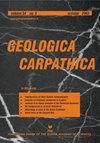Variscan high-pressure metamorphism of kyanite-bearing paragneisses hosting eclogites in the Veporic unit, Western Carpathians: Evidence from Th–U–Pb dating of monazite
IF 1.5
4区 地球科学
Q4 GEOSCIENCES, MULTIDISCIPLINARY
引用次数: 3
Abstract
In view of a polyphase development of the northern Veporic pre-Alpine basement of the Western Carpathians it is important to determine the age of high pressure (HP) metamorphism known from eclogites occurring in this area. To do this, several monazite-bearing paragneisses were studied petrologically and monazite was dated by chemical (U–Th–Pb) method. Identified were remnants from high-pressure stage, i.e. phengite (Si apfu = 3.2–3.3), kyanite, rutile and Ca-rich garnet rims. Part of the present mineral assemblage may have been preserved from prograde stage (plagioclase) and part reflects re-equilibration during retrogression (biotite, major elements in garnet cores). However, Y and HREE in garnet cores were not homogenised and their profiles indicate origin during temperature rise. Peak metamorphic conditions (P = 21 kbar; T = 650 °C), and retrogression stage (P = 9 kbar; T = 520 °C) were calculated using Zr-in-rutile, and Y-in-garnet and monazite thermometry, phengite composition and pseudosection modelling. Monazite yielded dominant Early Carboniferous age (354 Ma) with subordinate amounts of Ordovician (485 Ma) and Cambrian (505 Ma) ones, and no Alpine record. The monazite position in garnet cores predating the growth of Ca rims suggest that the Carboniferous age of 354 Ma probably predates the peak conditions and refers to the prograde stage of the Variscan metamorphic evolution.喀尔巴阡山脉西部Veporic单元蓝晶石共生副片麻岩榴辉岩的华力西高压变质作用:独居石Th–U–Pb定年证据
鉴于喀尔巴阡山脉西部维波里纪-阿尔卑斯前基底的多相发育,确定该地区榴辉岩中已知的高压变质作用年龄是很重要的。为此,对几种含独居石的副片麻岩进行了岩石学研究,并用化学(U–Th–Pb)方法对独居石进行了年代测定。已确定的是高压阶段的残余物,即多硅白云母(Si apfu=3.2–3.3)、蓝晶石、金红石和富钙石榴石边缘。目前矿物组合的一部分可能是从前进阶段(斜长石)保存下来的,一部分反映了后退过程中的重新平衡(黑云母,石榴石岩芯中的主要元素)。然而,石榴石核中的Y和HREE并没有均匀化,它们的分布图表明了温度上升过程中的起源。使用金红石中的Zr、石榴石和独居石中的Y-测温法、多硅土成分和假截面模型计算了峰值变质条件(P=21kbar;T=650°C)和退变质阶段(P=9kbar;T=520°C)。独居石在早石炭世时代(354 Ma)占主导地位,在奥陶纪(485 Ma)和寒武纪(505 Ma)占次要地位,没有阿尔卑斯山记录。石榴石岩芯中独居石的位置早于Ca边缘的生长,这表明354 Ma的石炭纪年龄可能早于峰值条件,并指的是华力西变质演化的推进阶段。
本文章由计算机程序翻译,如有差异,请以英文原文为准。
求助全文
约1分钟内获得全文
求助全文
来源期刊

Geologica Carpathica
地学-地球科学综合
CiteScore
2.40
自引率
23.10%
发文量
26
审稿时长
>12 weeks
期刊介绍:
GEOLOGICA CARPATHICA covers a wide spectrum of geological disciplines including geodynamics, tectonics and structural geology, volcanology, stratigraphy, geochronology and isotopic geology, karstology, geochemistry, mineralogy, petrology, lithology and sedimentology, paleogeography, paleoecology, paleobiology and paleontology, paleomagnetism, magnetostratigraphy and other branches of applied geophysics, economic and environmental geology, experimental and theoretical geoscientific studies. Geologica Carpathica , with its 60 year old tradition, presents high-quality research papers devoted to all aspects not only of the Alpine-Carpathian-Balkanian geoscience but also with adjacent regions originated from the Mediterranean Tethys and its continental foreland. Geologica Carpathica is an Official Journal of the Carpathian-Balkan Geological Association.
 求助内容:
求助内容: 应助结果提醒方式:
应助结果提醒方式:


